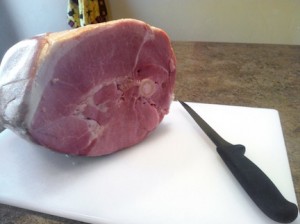Deciphering between uncooked, cured and ready-to-eat varieties of ham is often an arduous task. And because a mismanaged ham can turn out dry and flavorless, knowing how to prepare each variety will ensure your holiday feast is one to remember.
It’s important to know what kind of ham you’re cooking. Depending on the level to which the ham has been cured (if at all), the cooking process will vary greatly.
[Tweet “Depending on the level to which the ham has been cured (if at all), the cooking process will vary greatly.”]
Depending on how the ham was cured, it will most probably be necessary to soak the ham for 24 hours before baking it. This step isn’t necessary when boiling a ham as the boiling process automatically removes any excess salt, but it is a foolish errand to bake a salt cured ham without soaking..

Fully Cooked, or Ready-To-Eat
 When the process of smoking a cured ham raises its internal temperature to 150°F the ham is labeled “fully cooked” or “ready-to-eat.” Although these hams are safe to eat without further cooking, roasting them further will help to develop richer flavors, and give you an opportunity to add and caramelize a sweet glaze.
When the process of smoking a cured ham raises its internal temperature to 150°F the ham is labeled “fully cooked” or “ready-to-eat.” Although these hams are safe to eat without further cooking, roasting them further will help to develop richer flavors, and give you an opportunity to add and caramelize a sweet glaze.
But, roasting a “fully cooked” ham can be tricky. Set your oven too high and you’ll end up with a dry, flavorless ham. Under roast it and you will not have unleashed the hidden flavors, and sufficiently caramelized the glaze.
When it comes to preparing a moist and flavorful ready-to-eat ham, no one does it better than the folks at America’s Test Kitchen (ATK). Their army of chefs have tested several recipes and have come up with one in particular that guarantees to be a family favorite.
[Tweet “When the process of smoking a cured ham raises its internal temperature to 150°F the ham is labeled “fully cooked” or “ready-to-eat.””]
How to Cook Ham: Know Which Ham to Buy
Fresh ham is a raw uncured rear leg of a pig. The cut usually comes with the skin still on. The meat is typically pale pink to beige—the color of raw pork. This type of cut is perfect for roasting, or smoking. Because it hasn’t been cured it’s important that an internal temperature of at least 145°F is reached during the cooking process (per USDA recommended temperatures).
Here’s a great Ham Roast recipe from Cook’s Illustrated. With the right brine, the right sequence of oven temperatures (500 to 350°F), and the right glaze, you can transform an uncured ham into a pork roast with rich, moist meat and crackling crisp skin.
This type of ham is cured by burying it in a mound of salt or by rubbing the skin with salt. In some cases, sodium nitrite is also added to quell the spread of harmful bacteria and protect the ham during the curing process. It’s usually hung and air-dried for 6-18 months at cool temperatures allowing for dehydration and concentration of flavors. Often a dry cured ham is smoked at low temperatures to help enhance the flavor.
Typically, manufacturers dry-cure ham between 54-74°F. Humidity and air speed are also controlled as growing mold can impede evaporation of water by closing pores on the surface. Cold smoke (<68°F) is applied during the curing process to inhibit the growth of bacteria on the ham surface and prevent mold from growing. It also imparts a different flavor to the final product.
Dry cured hams, like prosciutto and jamon serrano, can be eaten uncooked and at room temperature. You don’t have to worry about foodborne bacteria – the combination of salts and nitrites will have rendered bacteria harmless.
[Tweet “Dry cured hams, like prosciutto and jamon serrano, can be eaten uncooked and at room temperature.”]
Should you boil a ham before baking?
FAQ
Should you soak a ham before cooking?
How long to soak ham in water to remove salt?
How long to soak ham in cold water?
What is the best way to prepare a precooked ham?
Should you soak a Ham before baking?
A country ham is much saltier and drier than a city ham, and soaking draws out some of the salt and prepares the ham for roasting or baking. The Virginia-based Smithfield, a major producer of country hams, suggests soaking a whole ham in water for at least 24 hours, changing the water every four hours, then scrubbing it before baking.
How long can ham be without refrigeration and still be safe?
Most food experts recommend that ham, should not be left out at room temperature for more than 2 hours. After that time, you should discard it.
Can you soak a Ham in water?
Soak Ham in Water Taking a bath in water will help cut down on ham’s saltiness. There are two ways to approach this. First up, the simple route: “Soak the ham in water overnight,” Rose says. You can even soak it for up to 48 hours.
How long do you soak a salted ham?
Consider this a reverse brining. By soaking the salted ham in water, the salt is drawn from the meat while adding moisture. Some say it’s necessary to soak a country ham for about 6 to 12 hours. If you have a small ham, around 4 to 5 pounds this might be okay but some like to soak the ham for a long time, about 2 to 3 days.
